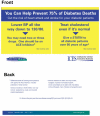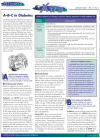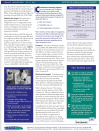The Ontario printed educational message (OPEM) trial to narrow the evidence-practice gap with respect to prescribing practices of general and family physicians: a cluster randomized controlled trial, targeting the care of individuals with diabetes and hypertension in Ontario, Canada
- PMID: 18039361
- PMCID: PMC2217527
- DOI: 10.1186/1748-5908-2-37
The Ontario printed educational message (OPEM) trial to narrow the evidence-practice gap with respect to prescribing practices of general and family physicians: a cluster randomized controlled trial, targeting the care of individuals with diabetes and hypertension in Ontario, Canada
Abstract
Background: There are gaps between what family practitioners do in clinical practice and the evidence-based ideal. The most commonly used strategy to narrow these gaps is the printed educational message (PEM); however, the attributes of successful printed educational messages and their overall effectiveness in changing physician practice are not clear. The current endeavor aims to determine whether such messages change prescribing quality in primary care practice, and whether these effects differ with the format of the message.
Methods/design: The design is a large, simple, factorial, unblinded cluster-randomized controlled trial. PEMs will be distributed with informed, a quarterly evidence-based synopsis of current clinical information produced by the Institute for Clinical Evaluative Sciences, Toronto, Canada, and will be sent to all eligible general and family practitioners in Ontario. There will be three replicates of the trial, with three different educational messages, each aimed at narrowing a specific evidence-practice gap as follows: 1) angiotensin-converting enzyme inhibitors, hypertension treatment, and cholesterol lowering agents for diabetes; 2) retinal screening for diabetes; and 3) diuretics for hypertension.For each of the three replicates there will be three intervention groups. The first group will receive informed with an attached postcard-sized, short, directive "outsert." The second intervention group will receive informed with a two-page explanatory "insert" on the same topic. The third intervention group will receive informed, with both the above-mentioned outsert and insert. The control group will receive informed only, without either an outsert or insert.Routinely collected physician billing, prescription, and hospital data found in Ontario's administrative databases will be used to monitor pre-defined prescribing changes relevant and specific to each replicate, following delivery of the educational messages. Multi-level modeling will be used to study patterns in physician-prescribing quality over four quarters, before and after each of the three interventions. Subgroup analyses will be performed to assess the association between the characteristics of the physician's place of practice and target behaviours.A further analysis of the immediate and delayed impacts of the PEMs will be performed using time-series analysis and interventional, auto-regressive, integrated moving average modeling.
Figures
References
-
- Medicine I. In: Guidelines for clinical practice: From development to use. MJ F and KN L, editor. Washington, DC, National Academy Press; 1992.
LinkOut - more resources
Full Text Sources
Research Materials
Miscellaneous




